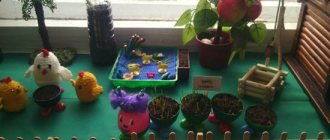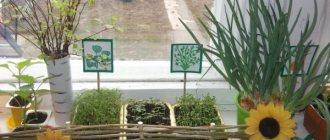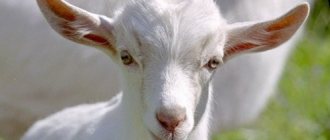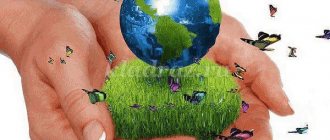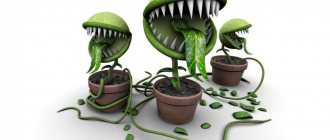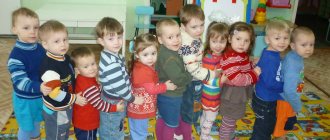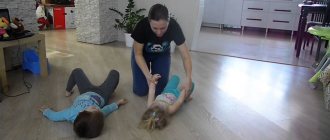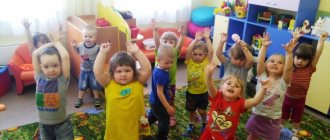Project “Vegetable garden on the windowsill” in the 2nd junior group of kindergarten
Project “Vegetable Garden” in the second junior group
This material is offered to teachers on the eve of spring and the upcoming “vegetable gardens on the windowsill.”
Authors of the project: Pankrasheva O.I., Arzhanova V.S. Duration : April-May 2016
In our work we use technologies from S.N. Nikolaeva “Young ecologist”, N.A. Ryzhova “Our home is nature”. Project participants: teachers, children of the second junior group, parents. Relevance of the project
Many parents who have their own gardens (dachas) do not suspect that the green kingdom will begin to arouse the child’s great interest if adults teach them to observe the plant, to see in the green sprout a special living creature, whose life depends entirely on whether it receives care or not.
Only with the help of adults can a preschooler understand that the life of a plant depends on the presence of heat, light and good soil, and learn to distinguish a healthy and strong plant from a weak, frail one that requires “treatment.” Having learned to understand the state of plants, the child will sympathize and care for them. Thus, the tasks of cognitive-research, social-personal, and aesthetic development of the child are solved. Young children love to act. They understand the world around them practically, and their actions by observing the results. Practical activity is the direct participation of children in caring for plants. Introduction to feasible work caring for plants is, first of all, the development of such qualities as responsibility for completing an assignment, for the result obtained, commitment, and determination. And these are very important qualities for a child’s education at school. However, the problem is that children of primary preschool age do not have sufficient understanding of plants, where they grow, the necessary conditions for their growth, and their interest in cognitive and research activities is not sufficiently developed. To satisfy children's curiosity and instill the first skills of activity and independent thinking, we have created conditions for children's search and research activities. Familiarization with the growth and development of plants can be done in the winter-spring period by growing various crops from seeds and bulbs in the kindergarten premises, using a vegetable garden on the window. Project participants worked taking into account the following principles: 1. Respect: the child has rights (respect for the rights of the child). 2. Rethinking: people begin to value what they did not value before (revaluation of the value system), abandoning the consumer approach to nature and limiting consumption in general, a new look at their behavior, at the environment, the formation of environmentally literate behavior. The goal of the project: to create conditions for the cognitive development of children through design and research activities and the organization of artistic and productive creative activities. Involving parents in joint research activities, developing an environmental culture among children and parents. Objectives: • To develop children's knowledge about the growth and needs of plants; To develop the ability to observe and care for garden crops; Develop curiosity, interest in research and experimentation; • Promote understanding of various aspects of human interaction with nature. • Develop environmental thinking and creative imagination in the process of experimental and research activities of children. • Improve the nature and content of generalized methods of examining objects using a system of sensory standards and perceptual actions, learn to make the optimal choice of standards in accordance with the cognitive task. • Teach children to show initiative and curiosity in order to gain new knowledge. • Foster a humane attitude towards all living things, teach correct behavior in the natural environment, lay the foundations of an individual’s ecological culture. Problem : While walking near the place where there was a vegetable garden in the summer, the children remembered what grew there last summer. The teacher asked: “Guys, can there be a garden indoors?” The children unanimously said that this was impossible. The teacher suggested trying to grow a garden in a group. When the children came to the group, they spent a long time figuring out where they could do this. With the help of the teacher, we came to the conclusion that one of the window sills in the group would be suitable for this purpose. Project implementation. The children identified a number of questions that were unclear to them.
What grows in the garden? How and why do plants grow? What do you need for a garden in a group? Project work plan.
Stages of project implementation
Stage 1 – preparatory Selection of visual teaching aids, acquisition of necessary materials and equipment, selection of fiction and scientific literature. Conversation about the garden, vegetables. Stage 2 – main Examination of books and illustrations about the inhabitants of the garden.
D/game “Tops and Roots” Reading the fairy tale “Tops and Roots” Conversation about what plants need to grow. Reading the fairy tale “Puff” D\game lotto “fruits and vegetables” Practical activity: planting (onions, garlic, dill, beans, peas) D\game “Right-wrong” Solving riddles about vegetables. Conversation “Conditions necessary for plant life” Reading the poem by Y. Tuvim “Vegetables” Modeling “Vegetables” Observation of the growth of seedlings. Watering plants in the garden. D\game “What vegetable is this part from?” Solving riddles about vegetables. Conversation “How do plants absorb water?” Consideration of the diagram “How beans grow” D\game “Find a pair” Conducting a relay race “Vegetables and fruits” Learning a poem about onions D\game “Which plant is gone?” Reading poems about beets, potatoes Reading the fairy tale “A Cheerful Vegetable Garden” Application “Vegetables” Outdoor game “Tasty Lunch” Observing the growth of plants in the garden. Watering plants in the garden. Analysis of changes. D\game “Distribution of fruits by color” D\game “Name the plant” Reading the fairy tale “A Tale about Vegetables” (funny) Reading proverbs about vegetables. P\game “Edible-inedible” D\game “Guess what’s in your hand” Consideration of the onion germination pattern. Coloring with paints. Didactic game “Cultivated and wild growing”. Reading the fairy tale “Therapeutic fairy tale about healthy vegetables.” Conversation “How a plant grows” Looking at pictures of vegetables. D\game “Where does it grow?” Solving mysteries about nature. A conversation about the benefits of vitamins contained in vegetables. Reading the fairy tale “Vegetable Dispute” Conducting the relay race “Who should we treat with what?” Consideration of the germination pattern of onions. D\game Game “Good - Bad” Conversation “Healthy vegetables in our diet” P\game “Droplets go in circles” Reading the fairy tale “About the Green Cucumber” Drawing “Vegetables” Conversation “The vegetable garden on the window is transferred to the kindergarten plot.” Stage 3 – final Exhibition “Our Vegetables” Exhibition of photographs “We are young gardeners!” Processing and design of project materials in the form of a presentation. Performance analysis Project
During the course of the project, children's ideas about plants as living organisms, about the conditions necessary for growth and development, developed an aesthetic sense, the ability to enjoy the beauty of the plants grown and the result of their work. Children learned to observe, began to treat the plant world more carefully, and interact correctly with plants according to the “do no harm” principle. All project participants (children, teachers, parents) received positive emotions from the results obtained. Prospects for further development of the project Our project confirmed that in the future it is necessary to promote the merging of the child with the nature of his native land, to form an aesthetic attitude towards it, to deepen knowledge, to improve skills, and to support the individuality of each child. And then the child will show interest in research and cognitive activities, and will independently and creatively master new methods of research for a more accurate result.
Applications
Fairy tales
The fairy tale “About the Green Cucumber” Once upon a time there was a green Cucumber. He got bored in his garden and decided to go on a trip. Walking past the neighbors of his garden, he met Pea. -Where are you going? – she asked. “Yes, I decided to look at the white light,” answered Cucumber. “Take me with you,” asked Pea. “Let’s go,” agreed Cucumber. And the two of them moved on. After all, traveling together is more fun. They walked and walked and came across a potato bush. He stands there and weeps bitterly. - What's happened? - asked the green cucumber. “The Colorado potato beetle has flown in and laid eggs on the leaf of my bush; larvae will soon emerge from them and eat me,” said Potato, still crying. – How can we help you? – the travelers asked. – Take a watering can with chemicals diluted in it, water me, the eggs will die, and the Colorado potato beetle will no longer land on the bush. By autumn, many tasty, large potato tubers will grow. So they did. Potato thanked Cucumber and Pea, and they moved on. Soon they heard a cry for help: “Help!!!” It was Cabbage screaming. She told them that a strong wind had torn a board from the fence and if it was not nailed into place, then the goats walking near the garden would sneak into the garden and feast on fresh green cabbage leaves. Having helped the cabbage, our travelers continued on their journey. Approaching a patch of carrots, they saw a huge field mouse preparing to dine on the ripe orange root vegetables. Green Cucumber and Pea helped the carrots and drove away the mouse. It began to get dark and Cucumber and Pea thought that it was time for them to return home. But at that time they saw a flock of noisy sparrows, which was approaching closer and closer. They rushed to look for shelter and heard: “Hide here.” They hid under large cabbage leaves. The sparrows did not notice them and flew past. Meanwhile, the green Cucumber and Pea returned home safely.
"Merry vegetable garden"
This is a short story about vegetables. One day a puppy was walking through the garden and met its inhabitants. But I just didn’t know what their name was. We need to help the puppy learn about the inhabitants of the wonderful garden. First the dog saw a green and pimply creature. Who is it? So this is a cucumber, a real brave daredevil. Then he met a handsome red man. It was ripe, juicy and a little chubby. It's Signor Tomato! And here is a business lady, she is dressed in a hundred fur coats. And in the summer she is not the least bit hot. This is cabbage that just can't get warm. Who is it that exposed his side to the sun? He didn't tan, but just turned a little white. Yes, this is a couch potato. He walked further and saw colorful bushes. These were sweet peppers of different colors: red, orange, yellow and green. He also saw a girl whose braid was always on the street, and she herself was sitting in prison. Who is this? Of course, carrots. Now the puppy knows who lives in the cheerful garden. It is inhabited by wonderful people.
"The Tale of Vegetables"
(funny) Grandfather planted a turnip. And I expected her to grow very, very big. It's time to. Grandfather began to dig turnips. He pulls and pulls... And then he hears that the vegetable is talking to him. - Grandpa, what kind of turnip am I to you, I’m a red carrot with green curly hair! “These are miracles,” says the grandfather, “but where did I plant the turnip?” I do not remember. Get into my basket, you’ll need it for soup, but in the meantime, we’ll look for it together. He walks further through the garden. Pulls and pulls... “Oh, be careful with me, I’m not a turnip, but a beet,” answered the burgundy lady in a businesslike manner. “How can that be,” says the grandfather, “I got it mixed up again.” I'm an old fool. Well, come with me, you’ll need some borscht. He moves on. “You’re probably a turnip,” the grandfather turned to another vegetable. - Who am I? No, what are you? I'm a potato. “Here you go,” muttered grandfather, “oh, old age is not a joy.” He's blind and has problems with his memory. How can I find a turnip? “Here I am,” exclaimed the turnip, “how long can I wait for all of you?” I'm sitting here, bored, alone. “Finally,” the grandfather rejoiced. I wanted to pull it out, but a really big, big turnip was born. Probably we should call our grandmother, granddaughter and others.
"Vegetable Dispute"
This is an autumn tale about vegetables. Once upon a time there lived an old man and an old woman. Grandfather watched TV in the evenings, and grandmother knitted socks for him. They became bored with living like this. We decided to get a vegetable garden. They spent days fiddling with it. They really liked that time flew by quickly and it was not boring at all. It's time to sow the seeds. The grandfather did not entrust such a serious matter to the grandmother. I went to the market myself and bought everything. I decided not to call grandma, but to sow the seeds myself. But he stumbled, and all the seeds scattered throughout the garden. Grandfather came home gloomy. And he says: “Now how can we find out where the carrots are and where the beets are!” “Don’t worry, grandfather,” said the grandmother, “the time will come, we’ll figure it out ourselves.” Autumn has come, it's time to harvest. An old man and an old woman were watching, and the vegetables were all so beautiful and ripe. But they argue with each other about which of them is better and more useful. - I am a tomato, I make a delicious tomato. I'm the best. - And I’m the most useful of all. I am the onion, I save everyone from illness. - But no. I'm also rich in vitamins. I am a sweet and very tasty pumpkin, and I am also very bright and beautiful. “You’re not the only one who shines with beauty.” I am a red carrot, I am a beautiful girl. Healthy and tasty, everyone really likes it. The vegetables argued for a long time until the grandfather and grandmother said: “You are all in charge, important and useful. We will gather you all, we will not leave anyone in the garden. Some will go into porridge, some into soup, and many of you will eat it raw and very tasty. The vegetables were delighted, laughed and clapped.”
A therapeutic tale about healthy vegetables.
Part one This fairy tale about vegetables is perfect for those children who have problems with food. Approximate age: from 3.5 years. Many children enjoy conversations about tasty and healthy food, as well as junk food. The main thing is that they are interesting. If you are telling a therapeutic story, you should not use your child's name for the main character. Katya, as usual, was visiting her grandmother during the summer holidays. She really liked this village. The bright and warm sun always lifted my spirits, and I could always swim to my heart's content in the clean river. Only Katya was very often capricious and did not obey her grandmother. She did not want to eat cooked vegetables and fruits. The girl refused to eat them and said: “I don’t want this, I won’t do this. I don’t eat this green one, but take away this red one.” And everything like that. Of course, this greatly upset the grandmother, because she tried so hard for her beloved granddaughter. But Katenka couldn’t help herself. A therapeutic tale about healthy vegetables. Part two One day a girl went outside and heard someone talking in the garden. She came closer to the beds and was very surprised. The vegetables were arguing among themselves. “I am more important than anyone in the world,” said the potato, “I am able to saturate the entire body and give strength for the whole day.” Thanks to my beneficial properties, every child will run, jump, gallop for a long time, and will not get tired at all. - It’s not true, I’m the most important! - said the beautiful orange carrot. You have no idea how much beta-carotene is in me - a supervitamin. It is good for vision. “Hmm,” Katya thought, “grandmother probably loves carrots very much, since she still knits and reads without glasses.” Meanwhile, the vegetables continued to argue: “Dear friend,” the pumpkin joined the conversation, “don’t think that you’re the only one rich in beta-carotene.” I have plenty of it too. I help people cope with autumn ailments. I also contain vitamin C. “I also have this vitamin,” the red pepper answered playfully, “I have much more of it than citrus fruits.” - No, guys, of course, you are important, but I’m still the most important! - said broccoli. - You can eat me not only boiled, fried or stewed, but also raw. I contain the most useful vitamins. And the soup I make is excellent. - Friends, you are all right, of course, but without me the dishes don’t turn out as tasty. - said the bow in a deep voice, - and I can cure a person of various diseases. And then the vegetables noticed that someone was watching them, and they immediately stopped their argument, as if they were not talking at all. - These are miracles! - Katenka said quietly. - And then the grandmother called her granddaughter to eat. Katya realized that she was very hungry and ran to wash her hands. When the girl saw that pumpkin porridge was waiting for her for breakfast, she was very happy. She wanted to try all the vegetables herself and choose which of them was more important and tastier. Katya decided that now she would enjoy eating her grandmother’s salads and porridge and would become beautiful and healthy.
Fairy tale game “Fruits and vegetables”
Visual material: pictures of vegetables. The teacher says: “One day a tomato decided to gather an army from vegetables.” They came to her with peas, cabbage, cucumbers, carrots, beets, onions, potatoes, and turnips. (The teacher puts pictures of these vegetables on the stand one by one) And the tomato told them: “There were a lot of people willing, so I set the following condition: first of all, only those vegetables will go to my army whose names have the same sounds as mine.” poommiidoorr.” - What do you think, children, what vegetables responded to his call? Children name, highlighting the necessary sounds with their voices: gorrooh, morrkoov, karrttoofel, turnip, cucumber, and explain that these words have the sounds p, p, as in the word tomato. The teacher moves pictures depicting the named vegetables on the stand closer to the tomato. Tomato conducts various training sessions with peas, carrots, potatoes, and turnips. Good for them! And the rest of the vegetables were saddened: the sounds that make up their names in no way fit the sounds of the tomato, and they decided to ask the tomato to change the condition. Tomato agreed: “Have it your way!” Come now, those whose names have as many parts as mine.” - What do you think, children, who responded now? Together we find out how many parts there are in the word tomato and in the name of the remaining vegetables. Each answer explains in detail that the words tomato and, for example, cabbage have the same number of syllables. Pictures depicting these plants also move towards the tomato. “But the onions and beets were even more saddened. Why do you think, children? The children explain that the number of parts in the name is not the same as that of a tomato, and the sounds do not match. - How to help them. Guys? What new condition could a tomato offer them so that these vegetables would join his army? The teacher should lead the children to formulate the following conditions themselves: “Let those vegetables come whose names have an emphasis in the first part” or “We accept into the army those whose names contain the same sounds (onions, beets).” To do this, he can invite the children to listen and compare where the stress is in the remaining words - the names of vegetables, and compare their sound composition. “All the vegetables became warriors, and there was no more grief!” - concludes the teacher. Distribution of fruits by color The teacher invites children to distribute fruits by color: put fruits with a red tint on one dish, yellow ones on another, and green ones on a third. The game character (for example, Winnie the Pooh) also participates in this and makes mistakes: for example, he puts a yellow pear with green fruits. The teacher and children kindly and delicately point out the teddy bear’s mistake and name shades of color: light green (cabbage), bright red (tomato), etc.
“Who should we treat with what?”
Goal: Know what animals and birds eat. Game actions: The leader throws the ball to the children and names the object (animal, bird), and the children answer and return the ball to the leader. For example, a sparrow - crumbs and seeds; tit - lard; cow - hay; rabbit - carrot; cat - mouse, milk; squirrel – pine cone, berries and so on.
Game "Good - Bad"
Goal: To improve children's knowledge about the phenomena of living and inanimate nature, animals and plants. Game actions: The teacher or teacher offers children different situations, and the children make conclusions, for example: “Is a clear sunny day in the fall good or bad?”, “All the wolves have disappeared in the forest - is this good or bad?”, “It rains every day - is it bad or good?”, “A snowy winter - is it good or bad?”, “All the trees are green - is it good or bad?”, “A lot of flowers in our garden - is it bad or good?”, “My grandmother in the village has is a cow good or bad?”, “All the birds on earth have disappeared - is that good or bad?” and so on. Word game I will read the words to you, and you think which of them are suitable for an ant (bumblebee, bee, cockroach). Vocabulary: anthill, green, flutters, honey, evasive, hardworking, red back, apiary, annoying, beehive, shaggy, ringing, river. Chirping, cobweb, flat, aphids, pest, “flying flower”, honeycomb, buzzing, needles, “jumping champion”, motley-winged, big eyes, red-whiskered, striped, swarm, nectar, pollen, caterpillar, protective coloring, repellent coloring. Game option: what words are suitable for a vegetable (fruit, etc.) “Where does it ripen?” Goal: To exercise the ability to use knowledge about plants, compare the fruit of a tree with its leaves. Game actions: Two branches are laid out on the flannelgraph: on one - the fruit and leaves of one plant (apple tree), on the other - the fruits and leaves of the plants. (For example, gooseberry leaves and pear fruits). The presenter asks the question: “Which fruits ripen and which don’t?” Children correct mistakes made in drawing up a drawing. Games Outdoor game “Tasty Lunch” Objectives: • Develop the ability to navigate in space, quickly act on a signal; • Learn to move rhythmically to music – Music; • Consolidate knowledge about the profession of a cook, products contained in culinary dishes, types of vitamins - Cognition; • Develop safe behavior skills while running – Safety; • Form initial ideas about a healthy lifestyle (eat vegetables and fruits containing vitamins) – Health; • To develop independence in arranging and cleaning physical education equipment – Labor; • Cultivate a friendly attitude with peers, the ability to interact in a group of peers – Socialization; • Cultivate a desire to communicate with adults in physical activity, maintain interest in outdoor play with speech accompaniment - Communication. Progress of the game: Teacher: Guys, tell me, who cooks cabbage soup so deliciously, Ruddy cutlets, Salads, vinaigrettes, All breakfasts and lunches? Children: Cook. Teacher: Where does the cook work? Children: In kindergarten, school, canteen, cafe. Teacher: What should a chef be like? Children: Know a lot of recipes, strong, love their profession, neat. Teacher: You and I now have to prepare lunch from vegetables and fruits. What are the benefits of vegetables and fruits? Children: They contain vitamins. Teacher: What vitamins do you know? Children: A, B, C. Teacher: We will prepare borscht. What is borscht made from? Children: From vegetables. Teacher: We’ll also make compote. What products are needed for compote? Children: Fruits (apples, pears, apricots, grapes) Teacher: The game we are going to play now is called “Tasty Lunch.” Maybe I will be the cook, and you will take on the roles of vegetables and fruits. Choose a medallion for yourself, put it on and examine it. Children choose medallions, the adult puts on a chef's hat and apron. Teacher: I remind you of the rules of the game: 1. Let’s jump to the music. With the end of the music, all the products run to their pots - hoops: a red hoop - borscht is cooked in it, a blue hoop - compote is prepared in it. 2. While running, keep a distance from each other, do not bump into each other, do not create dangerous situations; 3. The cook will praise those products that quickly and correctly find their pan. Teacher: The products gathered around the cook and joined hands: Children stand around an adult, join hands and walk in a circle, saying the words: You, our cook, don’t be lazy! Get to lunch quickly. Clean us quickly so that lunch will be tastier. Will you cook now: Delicious borscht, compote made from us. After finishing the words, they move to the music in jumps in different directions. When the music ends, they run to the pots - hoops. Teacher: Check yourself and your comrades to see if you are in the right place! And I will check whether you put all the ingredients correctly in the borscht and compote. You have prepared the dishes correctly. Now you need to quickly choose a mate and exchange medallions. Children exchange medallions with each other, the game is repeated from the beginning. Teacher's assessment of children's activities: Teacher: We had fun playing with you. You did a great job as a chef. Showed good knowledge about vegetables and fruits and knew how to run safely. I enjoyed your interaction when you exchanged medallions.
Outdoor game “Droplets go around in circles”
The teacher invites the children to play an interesting and magical game. But to do this you need to turn into small drops of rain. (Music sounds like rain) the teacher says the magic words and the game begins. The teacher says that she is Tuchka’s mother, and the guys are her little children, it’s time for them to hit the road. (Music.) The droplets jump, run, and dance. Mama Tuchka shows them what to do. Droplets flew to the ground... Let's jump and play. They got bored jumping around alone. They gathered together and flowed in small cheerful streams. (The droplets will form a stream, holding hands.) The streams met and became a big river. (The streams are connected into one chain.) Droplets float in a large river and travel. The river flowed and flowed and ended up in the ocean (children form a round dance and move in a circle). The Droplets swam and swam in the ocean, and then they remembered that Mother Cloud told them to return home. And then the sun just warmed up. The droplets became light and stretched upward (crouched droplets rise and stretch their arms upward). They evaporated under the rays of the sun and returned to mother Tuchka. Well done, droplets, they behaved well, they didn’t get into passers-by’s collars or splash themselves. Now stay with your mom, she misses you.
“Which plant is gone?”
Four or five plants are placed on a table. Children remember them. The teacher invites the children to close their eyes and removes one of the plants. Children open their eyes and remember which plant was still standing. The game is played 4-5 times. You can increase the number of plants on the table each time.
"Tops-Roots"
Children sit in a circle. The teacher names vegetables, the children make movements with their hands: if a vegetable grows on the ground, in a garden bed, the children raise their hands up. If the vegetable grows on the ground, the hands are lowered down.
"Name the plant"
The teacher asks to name the plants (third from the right or fourth from the left, etc.). Then the condition of the game changes (“Where is the balsam?”, etc.) The teacher draws the children’s attention to the fact that the plants have different stems. - Name plants with straight stems, with climbing ones, without stems. How should you care for them? How else do plants differ from each other? —What do violet leaves look like? What do the leaves of balsam, ficus, etc. look like?
"Choose what you need"
Object pictures are scattered on the Table. The teacher names some property or sign, and the children must choose as many objects as possible that have this property. For example: “green” - these can be pictures of a leaf, tree, cucumber, cabbage, grasshopper, lizard, etc. Or: “wet” - water, dew, cloud, fog, frost, etc.
"Guess what's in your hand"
Purpose: To distinguish vegetables, fruits and berries by touch. Game actions: Children stand in a circle, holding their hands behind their backs. The teacher places models of vegetables, berries and fruits in the children’s hands. Children must guess. The teacher shows, for example, a pear and asks to determine who has the same object (fruit, vegetable, berry).
Poems
Carrots are more useful than Pepsi and candy. It benefits everyone and there is simply no price for it. “About carrots” That carrots are very useful, Everyone has known this for a long time. This delicious root vegetable is respected by all the people. The first dishes are put into both roasts and salads. Make friends with her guys. So that your teeth don’t hurt and your mouth always turns white, strong, healthy and ready to eat. “A poem about sauerkraut” People love to eat sauerkraut and crispy cabbage, for example, almost everyone. It is boiled, fried, stewed, and often put into pies made of sifted flour. And it's good for salad. Very tasty little thing. “Poem about cabbage” Without cabbage, everyone knows, Ukrainian borscht cannot be cooked. They throw it in fresh, and don’t stew it or fry it, but from the sour one? do they cook cabbage soup? Delicious, just like borscht! “A poem about the benefits of cabbage” They chop it for the winter, salt it, ferment it, pickle it. After all, cabbage, as you know, is useful to us in all forms. It cleanses wounds and protects from stress, and is healing and tasty - we always need it. “Onion happiness” All athletes are friends with onions, adults and children love them. Even those who are on a diet must consume our green onion vegetable. After all, in all soups, borscht, main courses, vegetables, it gives a special taste. Don’t you believe us? Try! “About onions” Onions are a very hot vegetable, so it’s better not to touch them. Well, if you touch them, you need to wash your hands thoroughly and wash off all the bitterness of the onion. So to say, just in case, so that it doesn’t sting your eyes and bring you to tears. Because onions are angry and a little poisonous. But it is not at all dangerous and is not harmful to people, fortunately. This is how he treats our eyes. If our nose is stuffy, Doctor Onion will help him. “Miracle Tomato” Our miracle tomatoes, They ripen, but not soon And we will eat them to our hearts’ content, Sprinkling them with coarse salt. Treat friends and girlfriends The tomato is our best friend! “Miracle Vegetable” Our favorite tomato is simply a miracle vegetable. We have known for a long time that it adds health to everyone. It grows in the fields in the beds Red-red, sweet and sour. We yearn for it in the winter, and savor it in the fall. We can it and salt it so that you can eat it to your heart’s content afterwards. Thus, the Pomodoro will be waiting for us on the table all year long! “About the tomato” Children love tomato juice. It’s sweet, sour and pleasant. We use tomatoes in first courses and salads. The world would really be poorer if I didn't eat tomatoes. Our table would become poorer if the tomato didn’t know. That's why people love tomatoes, guys. “About peas” He couldn’t help but grow Our beloved king, the pea. His mother planted it for our joy. Together with us. We quickly pecked it down and didn’t even let it grow. They ate it along with the pods, Because they wanted it that way! **** How good he is, the first sweet pea. He sends greetings to kids and adult children from the garden beds. Seducing us with pods Every morning more and more. As soon as mom gives the command, we will remove him ourselves. “About potatoes” Living in the world without potatoes is very sad, children. This modest food always helps us out: And in puree, and in uniforms, In first courses, and in side dishes, And boiled, and baked, And crispy, and crushed. It’s not a sin to say about it that potatoes are the best! “Delicious potatoes” Even cats love them Our delicious potatoes. All the kids and animals are waiting for breakfast, preparing spoons. We fry it quite a bit, so that we can eat to our heart's content. Eat, kids, there's enough for everyone. I won't eat it myself! “About beets” You can’t cook borscht without beets, you can’t make vinaigrette. This vegetable is our friend And ready to be a salad. In any form, in different dishes, He will show his prowess - Not a capricious root vegetable, Let it grow for our joy. “About onions” An amazing thing. Everyone cries bitterly because of onions. Eat them quickly and you will immediately become healthier. “About a cucumber” They are drawn to the sun, to the warmth, Later to our table They just ask for a salad. Come on, crunch, guys, Cucumber salads. There are a lot of substances they need that are useful for people.
Sources:
• Ivanova A.I. “Ecological observations and experiments in kindergarten. World of Plants", M.: 2005. • Komarova N.G., Gribova L.F. “The world in which I live”, M.: 2006. • Nikolaeva S.N. “Education of ecological culture in preschool childhood”, M. “Prosveshchenie”, 2005. • Poddubnaya L.B. “Nature around us”, M. “Corypheus”, 2006. • S.N. Nikolaeva “Young ecologist”, • N. A. Ryzhova “Our home is nature”. • Blog of Marina Vitalievna Orlova website “Pantry of Entertainment”
Presentation on the topic: Garden
We recommend watching:
Research work about the native land in an elementary school. A vegetable garden on the windowsill in a preschool educational institution. An interactive literature lesson in the 5th grade. Tales of a Russian hut Generalization of the experience of social and pedagogical work with teenagers
Similar articles:
The project method and its place in modern methodology
Technology for implementing a social project
Presentation of project activities at school in accordance with Federal State Educational Standards
Junior group. Early childhood, nursery. Children 1-4 years old
Program for labor education of children from 1 year to 3 years old “Merry Garden” Explanatory note Labor education of the younger generation is one of the most important tasks of our society. An active, purposeful person, capable of self-realization, creativity, satisfying his interests in his chosen business and self-improvement is...
Summary of a lesson on speech development in the second group of early age. Topic: “Vegetables from grandma’s garden” Summary of a lesson on speech development in the second group of early age. Topic: “Vegetables from grandma’s garden ”
Objectives: Educational: • Teach children to distinguish and name vegetables (cabbage, onion, tomato, carrot, cucumber, summarize them in one word
“vegetables”
; • Continue to enrich the vocabulary...
